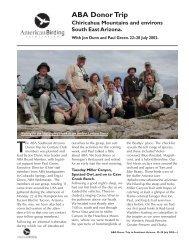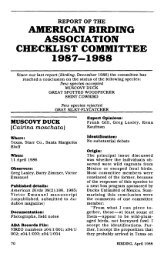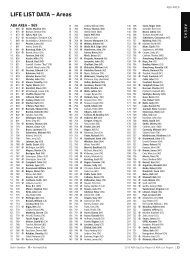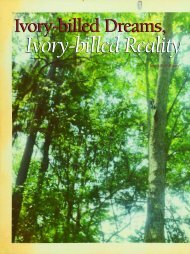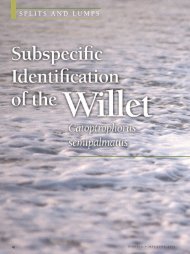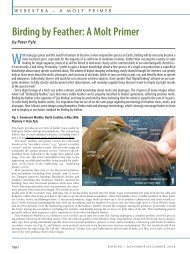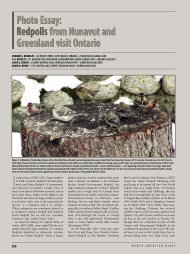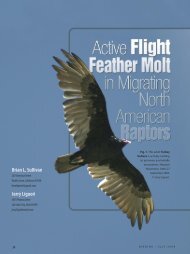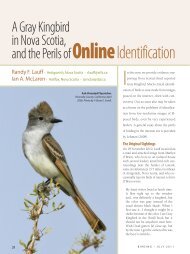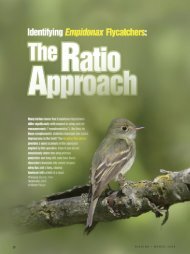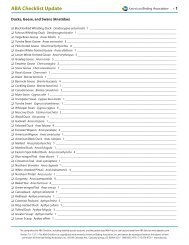warblers at all for the first hour. The Spruce Grouse made up for that, though, with a cacophonyof clapping and clucking—usually we’re happy to get one or two but we musthave heard close to 20!After a bit of effort we added the subalpine specialties—Boreal Chickadee, Pine Grosbeak,Gray Jay, <strong>American</strong> Three-toed Woodpecker, Lincoln’s Sparrow. By 5:30 a.m. wewere back down in the larches to rack up the woodpecker list, and quickly got Pileated,Black-backed, Hairy, Downy, Northern Flicker, Red-naped Sapsucker and Williamson’sSapsucker. We hooted again for Barred Owl, but only managed to get a big femaleCooper’s Hawk riled up. The big surprise there was a Solitary Sandpiper Russell spottedin a meltwater channel—I guess it was waiting for the higher marshes to thaw.At 6:30 a.m. we drove downhill into the ponderosa pine forests, hoping to find GrayFlycatchers and other pine specialties. We did get Western Bluebirds, White-breastedand Pygmy Nuthatches, Calliope Hummingbirds and a few other species, but no flycatchers.That would mean a difficult decision later on. Farther down we saw two largebirds in a tree—a Bald Eagle and a Golden Eagle! A Lazuli Bunting sang from the samespot, but the Lewis’s Woodpeckers weren’t on their favourite tree. At the bottom of thehill we added Lark Sparrow and Say’s Phoebe, and suddenly we were back in civilizationat Okanagan Falls, where the garden birds were added thick and fast—sparrows,magpies, crows, starlings.Although we were trying to maximize our species total, we did make some extra effortfor western species. We made a detour out of Okanagan Falls to find NorthernPygmy-Owl, but a staked-out pair seemed to have moved on, so we had to content ourselveswith other western birds such as Hammond’s Flycatcher, Western Wood-Pewee,Western Tanager and Bullock’s Oriole. Than a U-turn and back to Vaseux Lake to beginour waterbird list in earnest. Redheads, both scaups, Ring-necked Duck, Canvasback,Ruddy Duck, Common Goldeneye and Common Merganser all scoped on the lake. AVeery—my first of the year—called from the birch woods, while White-throated Swiftschattered overhead. We went over to the cliffs and struggled to find a Canyon Wren thathad been so obvious the day before but were happy to see a pair of Lewis’s Woodpeckersat last. Species number 117 at 8:00 a.m.—right on track. No Chukars called, though,so we continued south to McIntyre Bluff. Another detour there gave us Steller’s Jay andHouse Finch at last (phew), but no nutcrackers. Then a pair of Vaux’s Swifts twinkledoverhead—another nice western specialty.At River Road we hoped to get Yellow-breasted Chat, but it appeared the cold springhad kept them farther south. We did hear a Bewick’s Wren, though, a new resident ofthe Okanagan Valley and now one less species to look for on the coast. More sighs ofrelief when we heard a family of Clark’s Nutcrackers calling from the pines on the hillabove. Realizing we didn’t have MacGillivray’s Warbler yet—usually singing at higherelevations—we decided to check Inkaneep Park, a local migrant hotspot. But the woodsthere were silent except for a Black-headed Grosbeak and the insistent cu-coooo-cukof a pair of Eurasian Collared-Doves. Two more western birds on the list! Then we hadto decide whether to make the big detour up McKinney Road to get the Gray Flycatcherswe missed earlier. Russell insisted we do it—only 18 extra minutes and a greatwestern bird—why were we hesitating? So off we drove up hill, past the big Bank Swallowcolony (check!), across the sagebrush flats and up into the ponderosas again. Werolled down the windows at the km-10 cattleguard and chelep!—we were turningaround again and off to Osoyoos Lake.At Road 22 we stopped at a field to listen for a Grasshopper Sparrow heard the daybefore, but heard nothing but a Wilson’s Warbler from the bushes on the other side ofthe road (phew! Another missed warbler back on the list). No Peregrine Falcons weresoaring over The Throne, either. We worked our way down the Okanagan River channelto a good Yellow-breasted Chat location, but couldn’t hear any of their distinctive whistles.Luckily a Least Flycatcher was calling from the cottonwoods there—a very goodbird for this area in mid-May. Back at the fields we scanned for Long-billed Curlewsand Bobolinks and Pete quickly found both. Just as we were getting back in the car Iheard a distant series of whistles—chat! We left Osoyoos Lake at 10:30 with 145 speciesin the bag. A little behind schedule and a little behind on the species list, but nothingreally to worry about.We now turned west—the strategy here was to stop as little as possible over thenext 400 km to maximize our time on the Pacific coast. As Pete was phoning in an updateto Rob Butler, who was blogging about our progress, someone shouted “KING-FISHER!” and there were two shaggy-headed birds on the wire. Sighs of relief all round.A trio of Harlequin Ducks flying up the river were a nice addition as well. We stoppedbriefly at the Princeton sewage lagoons to pad our teal list, but the only new bird therewas a brilliant male Mountain Bluebird. We kept watching the river rocks for <strong>American</strong>Dippers, but hadn’t seen any by the time we reached Manning Park, so I decided weshould check the Similkameen at the Boyd’s Meadow trail. The trail was deep with snow,though, so we let Pete run on while we walked, listening for forest birds. Pete quicklyreported that it would be too far to go to the bridge, but we did have a Pacific Wrensinging so didn’t leave empty-handed. Sumallo Grove was next—the gate was inexplicablyclosed so we had to run along the road into the forest of huge cedars and Douglas-firs.Chestnut-backed-Chickadees, Brown Creeper and Red-breasted Sapsuckercalled as we ran, so we were happy to leave with most of our targets.Then it was freeway driving into the Fraser Valley. We took the Hunter Creek exit andquickly added Black-throated Gray Warbler, then on to the Fraser Highway for a moreleisurely drive through the rural bliss of a sunny spring day in the Lower Mainland. Wekept the windows down and were rewarded with the sputtering calls of Bushtits insouth Surrey. Our next major stop was the White Rock Pier, where Nathan had scoutedsome very nice seabirds over the past week. Although it was a Wednesday at 4:30 in theafternoon, the seashore was crowded with sightseers enjoying the sun and the stunningviews of snow-capped mountains. We threaded through the crowds as we ran out to theend of the pier with our scopes and tripods, but it was well worth the jog. We added ninenew species in quick succession, including a couple of Parasitic Jaegers that Nathanhad lined up for us—a hard bird to find on the BC coast in spring. We still needed a fewforest birds, though, so we stopped in at Sunnyside Woods and found Pacific-slope Flycatcherand Purple Finch. No Hutton’s Vireo, though.We were pinning our shorebird hopes on Boundary Bay, and Blackie Spit in particular.And it came through with flying colours—a mixed flock of shorebirds greeted ourscopes with Black-bellied Plover, Red Knot, Dunlin, Whimbrel, Sanderling and WesternSandpiper. Elated, we decided to take a detour to Colebrook Road where Nathan hadseen some good birds the previous week—Blue-winged Teal, Green-winged Teal, LesserYellowlegs all added in quick succession. Suddenly our goal of 200 species was withingrasp. We had 179 species and it was only 6:00 p.m.—there were three more hours oflight. We scanned the shore of Boundary Bay at the foot of 96th St. and our luck continued:six new species including a Merlin that rocketed by as we returned to the car. Acheck of a nearby barn netted a Barn Owl. Then it was off to Pete’s territory, the bordertown of Tsawwassen. He drove us down a residential street near his home, then stoppedand said, “Play the Hutton’s song”. Russell teed up his BlackBerry, but nothing answeredand after some quizzical looks from the neighbours we decided to give up. Justas we drove off, though, a Hutton’s Vireo began to sing loudly from the hedge. It alwayspays to keep your windows down!An overlook high above Georgia Strait produced Pelagic and Double-crested Cormorants,Pacific Loons and a pair of Black Scoters—then, as Pete had predicted, a maleAnna’s Hummingbird. It was only 5:20 and we had 193 species—the goal was tantalizinglyclose. We went as far west as we could go in Tsawwassen, out to the end of theferry terminal jetty. Black Oystercatcher and Brant were easily visible, and a quick scanof the south breakwater (only metres from the USA border) produced Brandt’s Cormorantand Pigeon Guillemot. Then off through the farm roads to Brunswick Point wherePete had been watching a small lingering flock of Snow Geese—and there they were!A quick stop at Canoe Pass to see one of the local Mute Swans turned into a few anxiousminutes, but at last we spotted one of the birds—and with that had beaten Russell’srecord of 197 by one species.We were tempted to drive down the road to Alaksen National Wildlife Refuge to getBarred Owl, but Russell wisely pointed out we could do that after dark, and we had tomaximize our daytime effort. So we turned north and drove under the Fraser throughthe Massey Tunnel, then out to the Vancouver airport and beyond to that Shangri-La ofbirding, the Iona Island sewage lagoons. The sun was going down in a proverbial ballof fire as I turned my attention to scanning the nest-boxes for Purple Martins. The otherssearched the marsh for any sign of the Black Tern that had been here for a few days.We struck out on both species, so as dusk fell we went into the sewage pond area. Peteand I flushed a big sparrow from the trail—Golden-crowned—number 199! Then wechecked a small flock of Canada Geese and saw the tiny Cackling Goose that had beenhanging out with them for the past while—number 200! Elated, we ran over to theriver for one last look at the martin boxes—nothing. Russell suggested we take a differentroute back in case we flushed up some Long-billed Dowitchers, and seconds laterhis prediction came true. Three dowitchers flew up, giving characteristic “keek!” calls,while another one remained back so we could study it in the lights of the sewage plant.With the record firmly in hand, we drove back down to Delta and onto Westham Islandto look for the Barred Owls that were nesting near the Canadian Wildlife Serviceoffices. As we pulled into the parking lot, the headlights shone on a blob perched on thewire—an adult Barred Owl. From the trees nearby a young owl hissed. It was 10:30p.m. and we had 202 species—time for bed.ONTARIO #1 – 21 May <strong>2011</strong> – 0000 to 0000 – Species totals: 194/193. (Team/shared).John Brett (194), Christian Friis (193), Stuart Mackenzie (194). Miles by Car: 780. Milesby Foot: 2. Visiting: Algonquin Provincial Park, Carden Plain, Burlington, Hamilton,6 | <strong>2011</strong> <strong>ABA</strong> <strong>Big</strong> <strong>Day</strong> <strong>Report</strong> & <strong>ABA</strong> <strong>List</strong> <strong>Report</strong>
Norfolk and Haldimand, Long Point. Species of Note: Common Eider (S), Atlantic Brant,Black-billed Cuckoo, Yellow-billed Cuckoo, Forster’s Tern, Least Bittern. Items of SpecialInterest: More than $5,000 raised for the Long Point Bird Observatory and Bird StudiesCanada.Coments: This <strong>Big</strong> <strong>Day</strong> was conducted by the Long Point Bird Observatory (LPBO)Cygnus Crusaders, a group of loyal LPBO supporters with the simple objective of increasingdiscretionary funding to support the research, education, and training programsof LPBO through Bird Studies Canada’s Baillie Birdathon. The crusaders weremade up of Christian Friis, John Brett and Stu Mackenzie.We gathered in Toronto on May 20th to prepare for what would be an incredibleweekend of Ontario birding. We made our way north scouting out as many locations aspossible toward our starting point in Algonquin Provincial Park. We arrived in Huntsvillelate that evening and shacked up for a good night’s sleep. The following morning wescrounged up some supplies and made our way toward our favourite haunts. As darknessovertook the park we settled in at the Mew Lake campground for a small feast andshort sleep before beginning our <strong>Big</strong> <strong>Day</strong>.We awoke shortly after midnight on May 21st to the call of an Eastern Screech Owl(a rare bird in Algonquin), and shortly thereafter our tents were packed and coffeebrewed while a Northern Saw-whet Owl let out some hoots just north of our site. Wespent the rest of the night and early morning hours desperately trying to find a BarredOwl, which was much harder than we anticipated. Our daylight birding began on theway to great boreal habitat along the Mizzy Lake Trail. By 4:45 the dawn chorus startedto muster and we began to quickly accumulate species. By the time we made it back tothe car we had picked up a great assortment of boreal specialties such as Boreal Chickadee,Gray Jay, and Black-backed Woodpecker; a Connecticut Warbler sang loudly outfrom the back of a stunted Black Spruce bog. We weren’t quite happy enough with ourspecies total to justify leaving the park, so we made our way to Opeongo Road andfound all the expected warblers that we had previously missed: Black-and-White, NorthernWaterthrush, and Tennessee Warbler. By 7:45 we had accumulated close to 100species and it was time to make our way south. On the way out we made a quick stopnear Canoe Lake to investigate a fruitless feeder and checked in on a family of Merlin.The drive to the Carden Plain was swift and the visit in Carden even swifter. In lessthan an hour we tracked down all the expected local specialties which included UplandSandpiper, Loggerhead Shrike, Sedge Wren, Golden-winged Warbler, Clay-colored andGrasshopper sparrow. Continuing south we observed a lone Trumpeter Swan on ReesorPond off Highway 407 in Markham.Our next objective was to maximize the amount of time along the Lake Ontario shoreline.This potentially time consuming strategy is risky, but has the potential to be veryproductive which was certainly the case this time around. A pair of female CommonEider floated not fare off Shoreacres Park in Burlington, and we found an Atlantic Brantat the Tollgate Ponds in Hamilton Harbour. Further down the lake a lingering femaleBlack Scoter was the icing on the Lake Ontario cake. Strong easterly winds the week previouslikely concentrated vagrants at the western end of Lake Ontario. The trip fromHamilton to Long Point was horribly unproductive as we struggled to add additionalspecies. At first glance, Townsend sewage lagoon was a bust, but a keen eye and a littlepatience paid off as we found a male Eurasian Wigeon. From Townsend we made ourway into Norfolk County and Long Point Country along the Lake Erie shoreline; TurkeyPoint – Red-headed Woodpecker and Bald Eagle, check! Our next goal was a one-stopbonanza at Backus Woods: Blue-winged, Prothonotary, Cerulean, and Hooded warblers,topped off with a Yellow-throated Vireo!We exploited mainland Norfolk as best we could and with daylight fading decided tovisit LPBO’s Old Cut Field Station. If we’ve learned anything over the years it’s never tounderestimate the power of 10 minutes at Old Cut. Wasting no time we found an OlivesidedFlycatcher, Yellow-bellied Flycatcher, Gray-cheeked Thrush, and hunted vigorouslyfor a Mourning Warbler and came up aces!Now for one final kick at the can for marsh birds. We had planned our trip well, butdid not account for one minor detail surrounding the May 24 weekend: fireworks on thebeach! The fireworks displays that engulfed the beaches of Long Point seemed to silenceany and all Least Bitterns, but we did manage to find a Common Moorhen. Our lastforay took us back to the mainland in search of Eastern Whip-poor-will, which wasn’ta problem, and we counted down the minutes searching scrupulously for a Barred orGreat-horned owl to no avail. As we settled down in Clear Creek for a final recount andreflection on the day, 194 species was our total, tying the second highest record in Ontario<strong>Big</strong> <strong>Day</strong> history!Twenty-four hours of some of the best Ontario birding in our lifetimes, a few monstermisses (where were the cuckoos?), and great friendships made for one memorableday in support of one great institution. Thank you to all of our sponsors who helped usto raise over $5,000 in support of LPBO.SASKATCHEWAN #1 – 25 April 11 – 0800 to 1100 – Species total: 40. Daniel Sawatzky(40). Miles by Car: 108. Miles by Foot: 2. Visting: Quappelle Valley along #99, ValeportMarsh, Condie Nature Refuge.SASKATCHEWAN #2 – 10 Sept 11 – 0800 to 1600 – Species totals: 60/60.(Team/shared). Daniel Sawatzky (60), Ryan Dudragne (60). Kilometers by Car: 352 km.Kilometers by Foot: 2 km. Visiting: Last Mountain Lake National Migratory Bird Sanctuary,Stalwart National Wildlife Area.SASKATCHEWAN #3 – 7 Oct 07 – 0900 to 1700 – Species total: 56. Daniel Sawatzky(56). Kilometers by Car: 275 km. Kilometers by Foot: 2 km. Visiting: Last Mountain LakeNational BirdSanctuary. Species of Note: Mountain Bluebird (L), Marsh Wren (L), Clay-colored Sparrow(L), Vesper Sparrow (L), Savannah Sparrow (L).SASKATCHEWAN #4 – 11 Nov 11 – 0900 to 1430 – Species totals: 33/33.(Team/shared). Daniel Sawatzky (33) Ryan Dudragne (33). Kilometers by Car: 110 km.Kilometers by Foot: 1 km. Visiting: Regina Beach. Species of Note: Surf Scoter (S),Barrow’s Goldeneye (S), Red-throated Loon (S).SASKATCHEWAN #5 – 1 Dec 11 – 0800 to 1700 – Species totals: 31/31. (Team/shared).Daniel Sawatzky (31) Ryan Dudragne (31). Kilometers by Car: 197 km. Kilometers byFoot: 1 km. Visiting: Quappelle Valley, Katepwa Lake, Mission Lake, Echo Lake. Speciesof Note: <strong>American</strong> White Pelican (LS), Long-tailed Duck (R), Barrow’s Goldeneye (S).John Vanderpoel gets a high-five for #510, a Yellow Rail at Anahuac NWR, Texas, on April 23, <strong>2011</strong>.Photo courtesy John Vanderpoel.<strong>2011</strong> <strong>ABA</strong> <strong>Big</strong> <strong>Day</strong> <strong>Report</strong> & <strong>ABA</strong> <strong>List</strong> <strong>Report</strong> | 7



